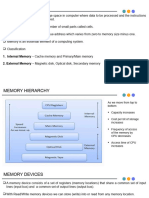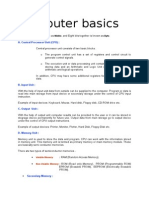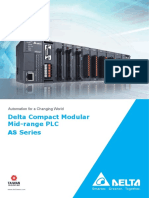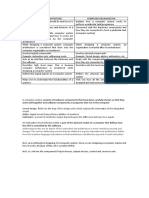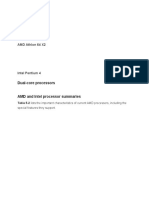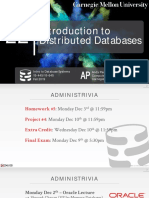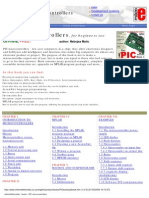Unit – II
Chapter -I
1. Storage Cell : -
• Storage cells are basic element for storage in computers. A variety of technologies are used
to fabricate storage cells.
• The main characteristics of any storage cell has two stable state (either ‘0’ or ‘1’ in binary).
• A stable state is that which does not change until it is intentionally disturbed.
Specifications of Storage Cell :-
1. Continuous power is required for stable state.
2. Whether a bit once written is permanently stored and cannot be altered by a user.
3. The time needed to write/read a bit in a cell.
Read – Control Signal to retrieve data through output line.
Write – Control Signal to retrieve data through input line.
Properties of Storage Cell:-
1. It must have 2 stable states.
2. Low energy must be consumed during stable state
3. Easy switchable between 0 to 1 and 1 to 0 state any number of times without losing
the data.
4. It should occupy very little space
5. Fast time to read/write
6. The data stored in a cell must not be lost with the passage of time.
7. Cost must be small.
Note : All properties may not be satisfied . for example, A faster read/write time will be
very costly.
1
�2. Physical Devices Used as Storage Cells
A number of different physical devices have been used to build storage systems of computers.
2.1 Capacitor Storage Cell
The Storage element used here is capacitor. A full charged capacitor is considered as Stable
state ‘1’. A discharged capacitor is considered as stable state ‘0’.
➢ To store data ‘1’ , A Voltage ′𝑣′ is applied at input & switch S1 is closed . Then capacitor
stores charge ′𝑣′ as stable state ‘1’.
➢ To read the state, switch S2 is closed so that it is read from output.
➢ For ‘0’ state storage , No voltage is applied.
Advantages :-
1. It is very less expensive
2. It requires small area for fabrication i.e., 0.02 µm2.
Disadvantages :-
1. It is Volatile storage cell (i.e. it require a frequent refreshing and charge)
2. Read out is destructive.
Example : Dynamic Random Access Memory (DRAM)
2.2 Flip-Flop Storage Cell
A flip-flop is a storage device that uses four semiconductor switches to either a 0 or 1.
2
� ➢ If the input supplied as ‘1’ with a write signal is applied to the Write line by closing S1 and
1 will be stored in flipflop and Similarly ,if the input supplied as ‘0’ , then it will be stored
in flip-flop .
➢ If the data stored in the flip-flop is to be read, a read signal is applied to the Read line by
closing S2 and the data stored in the flip-flop (0 or 1 ) appears on the output line.
Advantages :-
1. It consumes very less time to store a bit.
2. It is a permanent storage device and it does not required to e refreshed
3. The readout from flip-flop is non-destructive.
Disadvantages :-
1. Flip-flops are more expensive.
2. It requires more space because it consists four switches.
3. It is a volatile memory cell. Thus, it requires the power continuously.
Example : Static Random Access Memory (SRAM)
2.3 Magnetic Storage Cell
The physical device used as magnetic storage cell is a magnetic recording surface. The
method used to store data (1 or 0) on a magnetic surface.
➢ A data ‘1’ is written by sending a current through coil wounded on magnetic wire head .
This current creates a magnetic field.
➢ A plastic or metal surface is coated with a ferromagnetic material. This surface is kept
very close to the write head.
➢ The gap between head & plastic surface magnetizes the surface.
➢ A right to left magnetization (←) is considered as ‘1’ (i.e. writing 1) . Reversing of current
direction makes left to right (→) magnetization is considered as ‘0’(i.e. writing 0).
3
�➢ A magnetic resistive head is used to read data. The resistance increases if magnet with
S → N alignment is placed below it and resistance decreases for N → S alignment.
➢ The resistance is inversely proportional to current. Current increases for N → S alignment
and considered as ‘1’ as read. Current decreases S → N alignment and considered as ‘0’
as read.
Example:- HDD
2.4 Polycarbonate Storage Cell
➢ This type of storage cell used in Laser disks or compact disks. A polycarbonate surface
coated with reflecting material like aluminum and protective layer is further coated on
it.
➢ A laser beam is used to write ‘0’ or ‘1’. The laser is turned on to write ‘1’ by burning a
‘pit’ towards reflecting area. To write ‘0’ , the laser beam is defocused and no ‘pit’ is
burnt .
➢ Data is read by rotating the disk and a laser beam is used. Whenever there is a ‘land’ ,
light reflects from the reflective layer and no light gets reflected from a ‘pit’.
➢ The reflecting light sensed and is converted to electrical signal representing a ‘0’ or a
‘1’.
3. Random Access Memory
➢ The main memory of a computer is made using either capacitor storage cell or flip-
flops (as the physical device) to store data.
➢ A set of cells combined together to form a unit called a word. Each cell stores a bit, a
word consist of set of bits. The number of bits in a word is called word length.
➢ A word to be written is first stored in temporary register called Memory Data Register
(MDR). The location of organized memory is called Address.
4
� ➢ The address into which data is written or from which it has to be read is entered in
Memory Address Register (MAR).
➢ A Read / Write signal is used for appropriate operation.
➢ The address normally stars at 0, and the height address equals the number of words
that can be stored in the memory. For 'n' address locations the number of addresses
are 0 to n-1. The MDR should have 8 bits to accommodate 8 bits of a word.
Example : A RAM stores 256 MB and 16 bits are accessed in each memory read/write. What is
the size of MAR and MDR of this memory?
Solution : 16 bits are retrieved when a word is accessed so the size of the MDR is 16 bits.
Formula to convert Megabytes into bytes
MB * 1048576 = Bytes
=> 256 * 1048576 = 268435456 = 228 bytes
The number of bits in MAR is 28 bits.
There are two types of RAMs , Dynamic Random Access memory and Stats Random Access
Memory.
Dynamic Random Access Memory :
➢ The storage cell of DRAM is a Capacitor
➢ To store a bit of information in a Dynamic Random Access Memory chip, voltage should
be send to Charge a capacitor .
➢ DRAM will lose the data stored in it unless it is periodically refreshed
➢ DRAM is destructive readout memory
➢ DRAM is widely used to build the main memory.
➢ It stores one bit of information in each transistor
Statis Random Access Memory :
➢ The storage cell of SRAM is a flip-flop and it can hold without refreshing.
➢ The cycle time of SRAM is around 5 times shorter than DRAM.
5
� ➢ The Cost per bit of a SRAM is higher compared to a DRAM
➢ The Storage capacity of a SRAM is much lower compared to a DRAM.
➢ SRAM is faster , more reliable than DRAM is often used as Cache memory . It is smaller
than main memory.
➢ SRAM chips are also used in cars, household appliances , and handheld electronic
devices.
➢ SRAM uses a technology called CMOS which consumes very little power.
➢ SRAM is a non-destructive readout memory
➢ It requires four to six transistors to store a bit.
4. Read only Memory
➢ Read only memory uses semiconductor memory cells, which does not lose its data even
though the power is turned off . Due to this nature these memories also referred to as
non-volatile memory.
➢ The data stored in ROM is retained indefinitely.
➢ To read data from ROM the address of data stored is placed in Memory Address Register
(MAR). A Read signal issued so that copy of data in address location appears in Memory
Data Register (MDR).
➢ An important application ROM is to store tables which do not change.
Example : Seven-segment display commonly used in digital watches and calculations can be
designed using a ROM.
6
� S1, S2, S3, S4, S5, S6 and S7 are segments (a light emitting device) which can be
either lighted or not lighted.
A Table showing numbers (their binary equivalents) as input and segments of the
display to be lighted for each number.
For example , If we place 0 1 0 1 in the MAR (Corresponding to number 5) , the output bits
are S1=1, S2=0, S3=1, S4=1, S5=0,S6=1,S7=1.
➢ Another application of ROM is for storing small programs used to control devices such as
washing machines, microwave ovens , etc.
➢ Factory programmed ROM usually called ROM, the contents are written by manufacturer
and not erasable.
4.1 Types of ROM :
Basically there are many types of Read Only Memories with different capabilities. Some of
them are as follows.
7
� 4.1.1 Programmable Read only Memory ( PROM) :
The data programmed on PROM is permanent and it cannot be altered or erased.
4.1.2 Erasable Programmable Read only Memory ( PROM) :
There are two types of (Erasable Programmable Read only Memory )EPROMs known
as UVEPROM and EEPROM
UVEPROM (Ultra-Violet Erasable Programmable Read Only Memory ) facilities data
erasing and writing as many times as possible. The data can be erased by exposing to UV
rays.
In EEPROM (Electrically Erasable PROM), electrical pulses are used to create the contents
of PROM. Similar to UVEPROM that data can be written or erased any number of times.
The data is erased by supplying +5v dc to one of the pin.
4.2 Flash Memory
➢ A small variant of the electrically Erasable and Programmable Read only Memory is called
a Flash memory. Flash memories are semiconductor memories.
➢ Flash memory use one transistor per storage cell and capacity ranging from 8
GB to 1 TB.
➢ They are non-volatile (i.e. retain data stored in them without a power source)
➢ Data is written and read in large blocks of 512 to 4096 bytes
➢ The data rate is specified as 𝑛𝑥 , where 𝑥 150 KB/second and n is variable.
➢ There are two types flash memories : Stick shape (Pen drive) and Flat disk shape
(Memory Card).
➢ Flash Memory with high storage capacity are more expensive.
➢ They consumes little power.
5. Differences between RAM and ROM
RAM ROM
RAM stands for 'Random Access Memory' ROM stands for 'Read Only Memory'
Using RAM, both read as well as write Using ROM , only read operation can be
operations can be performed performed.
It is used for storing data and application It is used for storing start-up instructions
programs required for booting-up of the computer.
It is a volatile memory , Where data is It is a non-volatile memory, where in data is
completely erased as soon as the power not lost even after the power supply is
supply is switched OFF. switched OFF.
It is short-term memory It is long-term memory
Speed of RAM is high Speed of ROM is less
Different types SRAMs include:
Different types RAMs include: PROM (Programmable Read Only
DRAM (Dynamic Random Access Memory)
Memory) EPROM (Erasable Programmable Read
SRAM (Static Random Access Only Memory)
Memory) EEPROM (Electrically Erasable
Programmable Read Only Memory )
8
�6. Secondary Storage
Secondary memory (or) auxiliary memory is the slowest and cheapest form of memory. The data
present inside the memories cannot be processed directly by the CPU. Hence it is necessary to
initially copy the data present in secondary memory into the primary storage prior to processing.
Secondary memory is non-volatile in nature.
6.1 Magnetic Disk Drive
➢ A magnetic disk is a storage device that uses a magnetization process to write , rewrite and
access data.
➢ Magnetic disk covered with a magnetic coating and stores data in the form of tracks, and
sectors.
➢ A magnetic disk consists of several platters (magnetic plates ) are covered with magnetic
recording medium and platters are fixed to a spindle one below other to make up a disk
pack. This disk pack is sealed and mounted on a disk drive.
➢ For every platter , there are two read-write heads one for the top surface and the other
for the bottom. All heads are attached to a disk arm (Mechanical arm) that moves over on
platter.
➢ Each platter has the same number of tracks, Cylinder vertically formed by tracks.
➢ If a disk has n platters , there are 2n surfaces and thus 2n tracks per cylinder. Tracks are
circular divisions of the disk and it is divided into sectors
➢ The platters in the disk drive rotate around 7200 revolutions per second.
9
�If a disk has ' p ' sectors per track and a sector stores ' s ' bytes, them the storage in each track is
p × s bytes. If the disk has ' t ' tracks per surface and there 'm ' surface, the total storage
capacity of the disk is :
Total storage capacity = p × s × t × m bytes
Example 1: A hard disk has 16384 tracks on each surface. It has four plates. How many tracks
are there per cylinder? What is the total number of cylinders in the disk?
How many tracks are there in the disk?
Solution : There are four plates and hence 8 surfaces. The corresponding tracks in all the
surfaces constitute a cylinder. Thus there are 8 tracks in each cylinder.
Total number of cylinders = Tracks per surface = 16384.
Total number of tracks = Tracks per surface × number of surfaces
= 16384 × 8 = 131072
Example 2: What is the storage capacity of the disk with 131072 tracks, if there are 29824
physical sectors per track and each sector stores 512 bytes ?
Solution : Each track has (29824 × 512 ) bytes and there are 131072 tracks
The storage capacity of the disk is
= 131072 × 29824 × 512 = 1864 GB = 1.82 TB
6.2 Disk Interface Controller
➢ A Disk interface controller saves the precious time of CPU in reading / Writing.
➢ It also checks the data read for errors
➢ It can control several peripherals like disk, CDROM, Printer, etc.
10
� ➢ There are four standard interface controllers
1. SATA (Serial Advanced Technology Attachment)
2. SCSI (Small Computer System Interface ) - pronounced SCUZZY
3. Ultra wide SCSI
4. Fibre Channel Interface
➢ These standard interfaces are based on their data transfer rates & number of devices it
supports
➢ SATA most preferred for desktops since its cost is less.
➢ SCSI is a more expensive and used in most powerful computers (usually servers). It
supports more than four peripherals such hard disk, scanner, printer, etc.
➢ Ultra Wide SCSI hard drive falls in the latest interfaces of the SCSI standard and has high
data transfer rate.
➢ Fibre Channel is very expensive and it has the highest performance. It is used to control
several disks/peripherals . It can supports up to 127 peripherals.
6.3 Compact Disk Read Only Memory (CDROM)
➢ CD- Compact Disk is the medium in which data is recorded. A CD is a shiny metal disk
whose diameter is 12CM.
➢ It can store 700 MB which is equivalent of 3,00,000 pages of printed text.
➢ The data on CD is written as sequences of Lands and pits along spiral tracks.
➢ The Motor of CD-Drive rotates the disk at a speed of 360 revolutions per second.
➢ A Sharp Laser beam senses the lands and pits on disk and then they are converted into
0's and 1's.
➢ The rate of data retrieved is indicated is indicated by 𝑛𝑥 . where '𝑥' is nominal rate of 150 KB/second.
'n' is factor to be multiplied. For example 52𝑥 drive , the data is retrieved at a rate of
52 × 150 𝐾𝐵/𝑠𝑒𝑐𝑜𝑛𝑑 = 7.8 𝑀𝐵/𝑠𝑒𝑐𝑜𝑛𝑑
Major applications of CDROM are :
1. Distribution of software and Multimedia files.
2. Distribution of large texts such as encyclopedias, big manuals, etc.
11
�6.3.1 CD-R and CD-RW
➢ Compact disk recordable (CD-R) is used to store the information . CD-R disc cannot
be formatted and data cannot be deleted from it.
➢ A Compact disk recordable is also known as a Compact Disk-Write Once (CD-WO)
or Compact Disk - Write once read many (CD-WORM)
➢ CD-R is made of a polycarbonate plastic coating and it can read the information
using photosensitive dye.
➢ To write '1' on disk , laser beam is turned on . To write '0' on disk , laser beam is
not turned on.
➢ When the disk is inserted in a CD reader, it will sense 'lands' and 'pits' and
correctly interpret the sequence of 0s and 1s written on the CD.
➢ CD-RW term is known as CD-Rewritable or CD- Read Writable
➢ CD-RW are disks on which data can be written, erased and new data written.
CD-RW are mostly used to temporarily back up files.
6.3.2 Digital Versatile Disk Read Only memory (DVDROM)
➢ DVDROM is a digital versatile disk commonly used for storing large software applications
and it uses the same general principle as a CD but has a large capacity.
➢ The physical size of DVD is same as that of CD and storage capacity ranging from 4.7 GB
to 17 GB
➢ A DVD reader also uses a laser beam to read pits & lands as in a CDROM
➢ DVD can hold data on single or both sides.
➢ Single sided single layered DVD is known as DVD-5 and has capacity of 4.7 GB.
➢ Single sided double layered DVD is known as DVD-9 and has capacity of 8.5 GB.
➢ Double sided single layered DVD is known as DVD-10 and has capacity of 9.4 GB.
➢ Double sided Double layered DVD is known as DVD-18 and has capacity of 17 GB.
➢ There are several types of recordable DVDs are DVD - R , DVD + R and DVD ± RW.
➢ The 1𝑥 speed of DVD is 1.35 MB/ Second .
6.3.3 Blu-ray Disc
➢ Blu-ray disc can store large amount of data and was designed to replace DVDs
➢ The name Blu-ray is derived from the underlying technology , which utilizes a blue-violet
laser to read & write data.
➢ A single layer disc can store 25 GB , Double layer disc can store 50 GB, Triple layer disc can
store 100 GB and Quadruple can store 150 GB.
➢ The recording data rate is given as 1𝑥 where 𝑥 is 36 Mbits/second (i.e. 4.5MB/ second),
the maximum value of n is 12.
12
� ➢ There are two types of Blu-ray discs are : BD-R (Writable Once) and BD-RE (Recordable and
Erasable).
➢ Blu-ray disc and Blu-ray disc players are more expensive compared to DVD players and can
be used for high definition TV with much better quality.
6.4 Archival Store
➢ Archival store is used for data perseverance.
➢ A duplicate copy of data is kept either legal purposes or further analysis. They have to be
retained for a long duration and are called archives. The storage devices which stores the
duplicate data are known as archival storage units.
➢ Data archives are normally indexed so that searching and retrieving becomes easy.
Properties :
1. Storage medium should be removable
2. Should be Writable
3. Size must be proper (Usually in Terabyte (TB))
4. Should be non-volatile
5. Should have long life ( that means data should readable normally up to 30 years)
➢ Data is stored on a magnetic tape along one or more tracks.
➢ Half-Inch Cartridge (HIC) tape called Linear tape Open (LTO) Ultrium , which is currently
used as archival storage unit.
➢ There are several types of LTO Ultrium (LTO1 to LTO7) has capacity ranging from 100 GB
uncompressed to 16 GB compressed.
13
� Chapter -II
Central Processing Unit
1. Structure of a Central Processing Unit
The Central processing Unit (CPU) is considered as the brain of a computer. It is used to
manage all the functions performed by a computer. It communicates with the external world
through input and output devices. The user enters the data or instructions to the CPU through an
input device. These instructions are executed and the CPU will communicate the result through
output devices.
➢ The main purpose of a Central Processing Unit (CPU) is to retrieve instructions from the
memory, interpret them and carry out the operations specified in the instruction
➢ Inorder to perform the operations, CPU will communicate with the input Unit, the output
unit, the main memory and the secondary storage.
➢ CPU can send control signals to all these units and order them to perform required
operation.
➢ Central Processing Unit is used to interpret and perform various operations which is known
as an instruction set. Generally, an instruction set contains different operations to solve a
specific problem.
14
�An instruction must be specified with the following:
1. The operation to be performed
2. The storage locations of operands in the main memory which is known as “address of the
operand”
3. The address of the next instruction to be executed by the computer. Generally , the
instructions will be stored in consecutive locations and will be executed in a sequential
manner.
The hardware of CPU is used to interpret the operation codes. Address can also be represented
by using binary numbers.
Example : Program (Addition of Two Numbers ) to demonstrate how CPU executes the
instruction
Address where an An instruction
instruction is
Explanation
stored in memory Operation Address of
( word address) Code operand
Read a number from the input unit
O1 READ A
and store it in address A of memory
Read a number from the input unit
02 READ B
and store it in address B of memory
Take a number from address A and
03 LOAD A
put it in a CPU register
Take a number from address B and
04 LOAD B
put it in a CPU register
05 ADD A, B Add the value of A and B
06 STO C Store the sum in C in address C
Display the number stored in address
07 DIS C
C
08 STOP Stop execution
15
�2. Specifications of CPU
The specifications of CPU based on characteristics are as follows :
1. The variety of instructions it is designed to interpret and execute
2. The number of bits of data that are accessed from the main memory in one cycle.
Word length can be defined as the number of bits available in an instruction. The
microprocessors are manufactured by Intel company and increasing the word length from
one version to another version.
e.g : Intel 4004 -> 4-bit data
Intel 8008 -> 8-bit data
Intel 8086 -> 16-bit data.
3. The architecture (i.e. Internal structure of a processor) :
There are 3 architectures
➢ RISC (Reduced Instruction set computer) , it has very small number of instructions, and
simple control unit . It is used in High performance computers.
➢ CISC (Complex instruction set computer ) used in PC's . It has over 300 machine
instructions and a complex control unit.
➢ Multicore architecture :
Multiple Identical processors are integrated in one chip
Ex: Dual Core , Quad Core , etc.
4. Clock Speed : An important parameter used describe a CPU is its clock speed or frequency.
16
�5. MIPS rating of a CPU : Another parameter used to describe the speed of CPU is called its
mips (millions instructions per second).Normaly it is specified as thousands of mips.
6. SPEC rating of a CPU : MIPS is not reliable measure of CPU performance, another measure
called SPEC ( System Performance Evaluation Corporation).
3. Interconnecting of CPU with Memory and I/O Units
➢ CPU coordinates execution of instructions stored in main memory . Hence CPU is
connected to main memory through set of parallel wires called BUS. Bits are transferred
from the memory to the CPU and back via a bus.
➢ There are two buses that connects CPU & Main memory are address bus and data bus.
➢ The address bus carries the address of memory location to Memory Address Register
(MAR) from CPU.
➢ The data bus carries data or instruction from CPU to Memory Data Register (MDR) of
memory
➢ Another bus called Control bus is present which carries controls operations like Read /
Write from or to the Memory & Input / Output operations.
➢ The types of bus standards are
ISA (industry Standard Architecture ) for 8-bit PCs
EISA ( Extended ISA ) is a faster 32-bit bus
PCI (Peripheral Component Interconnect ) which allows 32-bit and 64-bit
implementations
➢ A motherboard has set of ports to connect units such as Display unit, keyboard , etc.
➢ The other connections are serial port, parallel port , Audio-Video jacks and USB port.
17
�4. Embedded Processors
Embedded processor is used for special purpose or specific application . It has simple
structure and executes a few instructions and Embedded processors are inexpensive.
Example: Controlling functionalities of Washing machine,
fuel and other controls in a car , etc.
There are two major categories
➢ Microcontroller : Microcontrollers are basically used for controlling appliances
Ex : Washing machine , Ovens, AC, etc.
➢ Digital Signal Processor (DSP) : Digital signal Processors are used to process
Audio & video signals.
Ex: CD-Player, Mobile, Camera, etc.
4.1 Microcontrollers
Microcontroller is a signal integrated chip that is programmed to control a particular
system and the devices are controlled by the set of instructions stored in a chip. One of the
application of a microcontroller is an automatic washing machine.
Washing machine follows specific sequence determined by various events like Water
leveling, Washing for pre-determined time, Rinsing for given time, draining and spinning.
4.1.1 Differences between Microprocessor and Microcontroller
➢ Microcontroller is a single task device whereas Microprocessor is a Multitasking
device.
➢ Microcontroller consumes less power whereas Microprocessor consumes more
power
➢ Microcontrollers used for specific purpose applications whereas Microprocessor
used for general purpose applications
18
� ➢ In a microprocessor, the memory, IO ports, timers etc. are connected to the CPU
externally. In a microcontroller, the CPU and all other elements are integrated
into a single chip or a board.
➢ The clock speed of a microprocessor higher than a microcontroller.
➢ Microprocessors are 32bit or 64bit. A microcontroller can either be 8 bit, 16bit or
32bit.
➢ A microprocessor cost more than a microcontroller.
➢ The size of the microprocessor board is large than a microcontroller chip.
➢ Personal computers and laptops are applications that use a microprocessor.
Microwave oven, washing machine are some examples for applications that use
microcontrollers.
4.2 Digital Signal Processors
➢ Digital Signal Processors (DSPs) are optimized to process real-time audio and video
signals. For example , A Live Cricket match in real time.
➢ A real time processor accepts input signals while it is being generated, for example, a
telephone conversation.
19
�➢ The input signal to a DSP is analog (Continuous signal) such as speech , music, video, etc.
➢ The Analog to digital converter (A/D) converts the analog input samples into required
digital input samples.
➢ The DSP takes the digital input samples from A/D converter and processes it based on
program stored in its memory and gives a processed digital signal as a bit stream.
➢ The Digital to analog converter (D/A) converts the processed digital signal back into
continuous analog signal.
➢ Most DSP applications for audio signal processing perform operations using formula
𝑦(𝑛) = 𝑥 (1)ℎ(𝑛 − 1) + 𝑥 (2)ℎ(𝑛 − 2) + 𝑥 (3)ℎ(𝑛 − 3) + ⋯ … + 𝑥 (𝑚)ℎ(𝑛 − 𝑚)
Where 𝑦(𝑛) is the nth sample output,
𝑥 (1) , 𝑥 (2) , 𝑥 (3) , etc are input samples of 𝑥 (𝑡 ) ( a function time ) .
ℎ(𝑛 − 1), ℎ(𝑛 − 2) are called adjustable weights.
The above formula is carried out using MAC. It consists of a multiply unit and an
accumulator with add/ subtract to store the product terms.
➢ The fast ALU performs arithmetic and logic operations .It has two ports . One port
continuously takes the input and the other ports gives the processed bit stream as output.
➢ The on-chip memory of a DSP is divided into two memory segments i.e. program memory
and data memory. The two memories has separate I/O lines to CPU.So an instruction can
be fetched to program memory and the result can be written in data memory.
➢ The most important units of DSP are :
• An A/D Converter
• A D/A Converter
• A Multiply Accumulate Unit
• A fast ALU which handles real-time arithmetic
• An on-chip data memory
• An on-chip program memory.
20
� Unit-II Questions
1. Storage Cell and its types.
2. Explain in detail about Random Access Memory(RAM)
3. Write about Read Only Memory(ROM)
4. Differences between ROM and RAM
5. Explain about Flash memory
6. What is Secondary Memory ? Explain about magnetic disk drive
7. Write a short note on Disk Interface Controller
8. Write about CDROM , CD-R and CD-RW
9. Explain about DVDROM and Blu-ray disc
10. Explain structure of CPU in detail
11. Write about specifications of CPU
12. Explain in detail about Interconnections of CPU with memory I/O units.
13. Explain embedded processor and its types (Microcontroller & DSP ) in detail.
21





